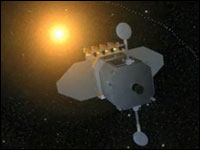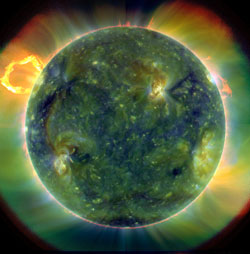

Two months after the launch of NASA’s Solar Dynamics Observatory, its first images are now arriving back on Earth with more detail about the sun than has ever been seen before.
Some of the images from the spacecraft reveal in new clarity the material streaming outward and away from sunspots. Others show extreme close-ups of activity on the sun’s surface.
The spacecraft also has made the first high-resolution measurements of solar flares in a broad range of extreme ultraviolet wavelengths.
‘A Dynamic Sun’
“These initial images show a dynamic sun that I had never seen in more than 40 years of solar research,” said Richard Fisher, director of the heliophysics division at NASA Headquarters in Washington.
The Solar Dynamics Observatory, or SDO, “will change our understanding of the sun and its processes, which affect our lives and society,” Fisher added. “This mission will have a huge impact on science, similar to the impact of the Hubble Space Telescope on modern astrophysics.”
Launched on Feb. 11, SDO is the most advanced spacecraft ever designed to study the sun. During its five-year mission, it will examine the sun’s magnetic field and also provide a better understanding of the role the sun plays in Earth’s atmospheric chemistry and climate.
Since launch, engineers have been testing and verifying the spacecraft’s components. Now fully operational, SDO will provide images with a level of clarity that’s 10 times better than high-definition television and will return more comprehensive science data faster than any other solar observing spacecraft.
NASA’s Goddard Space Flight Center built, operates and manages the SDO spacecraft for the agency’s Science Mission Directorate in Washington.
‘A Quiet Sun’
Though the sun is ever-changing, the images released this week suggest that it may be in a relatively quiet phase, Paul Czysz, professor emeritus of aerospace engineering at St. Louis University, told TechNewsWorld.
“In the images I saw, I counted only four sun spots — that’s almost corresponding to a sunspot low — and only one flare was shown in the sequence,” Czysz explained. “This is a quiet sun.”
More usual is to see eight or nine sunspots in such images, he added.
It’s important to monitor the sun’s activity, however, because of the effects it has on Earth’s weather, ozone and communications, Czysz noted.
The Northern Lights
The sun’s flares, for example, send out large bursts of material, and when that material reaches Earth, not all of it gets deflected by our magnetosphere, which is the shield created by the Earth’s magnetic fields, he explained.
“Like anything, the magnetosphere can be overwhelmed,” Czysz noted.
What makes it through to the Earth’s atmosphere is what creates the Northern Lights, he pointed out.
“If it gets to be a heavy downpour, that’s when we have problems with communications and even electrical networks,” he added.
A Window on Distant Stars
“You have to remember that the sun is the energy source that drives not only our solar system but also the Earth,” Czysz pointed out. “You want to keep track of it. The number of sunspots, the number of flares and even the granularity of what you can see can show the strength of the magnetic fields and what kind of flare bursts you’re going to get.”
Indeed, the SDO aims to determine how the sun’s magnetic field is generated, structured and converted into violent solar events such as turbulent solar wind, solar flares and coronal mass ejections.
In addition to providing new insight into weather and other events on Earth, understanding such astrophysical processes in the sun is also “extremely interesting astrophysically,” Nathan Smith, a post-doctoral researcher in astronomy at the University of California at Berkeley, told TechNewsWorld.
“It provides us with a window to the types of magnetic processes that may be occurring in much more distant stars where we do not have the luxury of seeing such detail,” Smith explained.
Like a New Pair of Glasses
That level of detail now provided by the SDO will likely lead to new insights, Smith added.
“To have that detailed resolution over the whole visible disk of the sun, and at several different wavelength bands, is likely to provide a leap forward in understanding the sun,” he concluded. “Seeing such detailed changes in temperature, density, and motion of the plasma over time is likely to challenge models of these magnetic phenomena for some time to come.”
Czysz likened the new capabilities to getting a new pair of glasses.
“With the old ones, you could see, but it was fuzzy,” he explained. “Now we can see clearly.”





















































